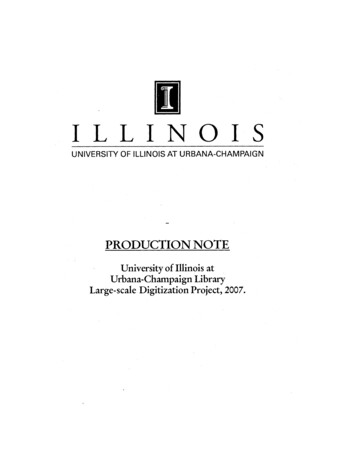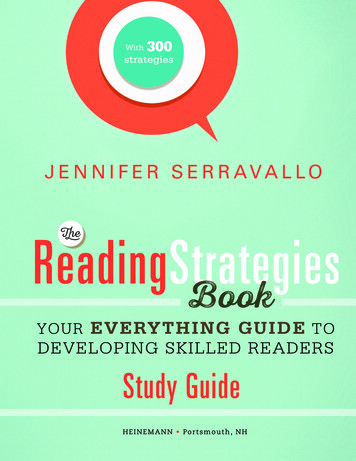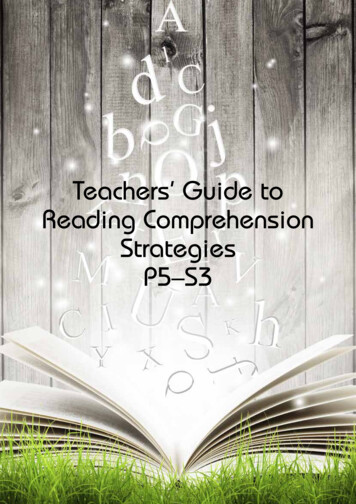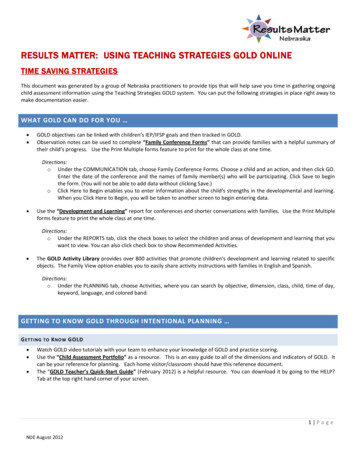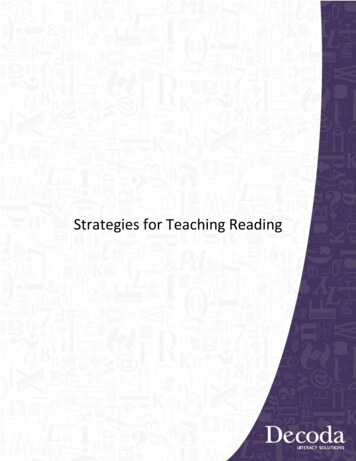
Transcription
Strategies for Teaching Reading
Strategies for Teaching ReadingAcknowledgementsThis set of teaching strategies was originally compiled by the National Youth Literacy DemonstrationProject. The project was conducted by Literacy BC in partnership with Surrey School District 36 from2002 to 2004, and was funded by the National Literacy Secretariat.For more information about and resources from this project, visit www.decoda.ca/practitioners/youthliteracy 2008, reprinted 2015, Decoda Literacy Solutions.This work is licensed under a Creative Commons Attribution-NonCommercial-NoDerivatives 4.0International License. It may not be commercially reproduced, but copying for other purposes, withcredit, is encouraged.Decoda Literacy Solutions560-510 Burrard StreetVancouver, BC V6C 3A8Phone: (604-681-4199Email: info@decoda.caWeb: www.decoda.ca
Strategies for Teaching ReadingBalancing Instructional Elements .1Brainstorming .3Clarifying . 5Click, Clunk .7Predicting .9Problem-Solving Scenarios .11Question Generating and Answering 13Reciprocal Teaching (RT) – Peer to Peer Teaching .15Role Plays .17Summarizing .19Teaching with PowerPoint or Overheads .21Think-Pair-Share .23
Balancing Instructional ElementsDescriptionMost learners can cope with only a few challenges at a time. The chart below outlines key factors toconsider when designing a learning activity. Limiting the number of factors that are challenging in anyparticular lesson allows students to focus on the knowledge and skills that are most critical. It's importantto achieve a balance between low and high challenge characteristics in your lessons. Lessons that relysolely on activities with characteristics from the Low Challenge column may be too boring, while thosethat are in the High Challenge column will frustrate most students.PurposeThis structure is designed to help teachers plan instruction so that the information and the activitiesprovided stay within the Instructional Zone of what students can handle. That is, students should beengaged in a level that is slightly above their current level of proficiency but should not be overwhelmedby both new information and new tasks.The Teaching Learning ContinuumFactorFromLow ChallengeToHigh ChallengeContextFamiliarNewTaskHighly StructuredMinimally DefinedProcessHighly ractPromptsVisualPrint-BasedTeacher aryCommon/EverydaySomewhatSophisticatedSentence StructureSimpleComplex1
What to DoUse the chart below to plan or analyze a lesson to see where it fits on the teaching/learning continuum.Teaching/Learning Continuum Planning AnalysisConsider all elements of your lesson (see left hand column). Describe each element and rate it from lowchallenge (1) to high challenge (5). Make sure you have a balance of challenging and not so challengingactivities and provide Scaffolding for tasks and activities that are important but may be difficult forstudents. If you have a multi-level class, you may need to increase the challenge level for a moreproficient group and reduce it for less proficient learners (in which case you would fill out separate chartsfor each group).Low ChallengeRate theChallenge LevelContextFamiliar1o 2o 3o 4o 5oNewTaskHighlyStructured1o 2o 3o 4o 5oMinimallyDefinedProcessHighlyFacilitated1o 2o 3o 4o 5oIndependentContentConceptsConcrete1o 2o 3o 4o 5oAbstractPromptsVisual1o 2o 3o 4o on1o 2o 3o 4o 5oTheoreticalVocabularyCommonEveryday1o 2o 3o 4o 5oSomewhatSophisticatedSentenceStructureSimple1o 2o 3o 4o 5oComplexFactorDescriptionTotal Rating2HighChallenge
Teaching Strategy: Oral CommunicationBrainstorming and OrganizingIdeasDescriptionBrainstorming is a process for creating a list of ideas in response to an initial question or idea.Brainstorming emphasizes broad and creative thinking, inviting all participants' points of view in an effortto ensure that all relevant aspects of an issue or question are considered. Example: If there is a hurricaneor another natural disaster, what should everyone do to be safe? It’s usually a good idea to use graphicorganizers such as “idea maps” or flow charts so students can see the relationship between variousideas. Brainstorming can be done with the whole class, in pairs or small groups, or individually. It alsolends itself to using the Think-Pair-Share strategy.PurposeBrainstorming provides an opportunity for students to generate ideas or solve a problem. In addition, theactivity prepares students to use brainstorming as a tool for work and personal planning. It also teachesthem to organize the ideas they have generated into logical sequences, into priority lists, or othermeaningful units and evaluate which ideas pertain to a topic, problem or a situation, and which ideas areinteresting but irrelevant to the topic at hand.What to Do1. Introduce a topic, ask questions and ask students to write their ideas on the board (or give them toone person writing responses on the board), either as part of a list or in the form of a graphicorganizer.2. Keep asking for more ideas and offer some of your own.3. Guide the brainstorm by scribing ideas as they come, stopping any comments that evaluate ideas,inviting new ideas, and encouraging the group to share their ideas freely. Help generate energy andfree-thinking through encouragement.4. Organize the ideas and make the organization explicit, saying something like Ah, you said we neededemergency supplies, so let me put “water” and “flashlight” under emergency supplies.5. After a few simple brainstorms on topics that students are familiar with, demonstrate howbrainstorming works and set some ground rules. All ideas, however simple, creative, or off the wall are welcome. No one will comment on the ideas during the brainstorm. If you wish, offer a one minute "quiet period" before the brainstorm for people to reflect upon orstart lists of ideas on their own.3
6. Explain what will be done with the brainstormed ideas.7. Ask for clarification of any ideas that are not clear to you or others.Keep in MindBrainstorming relies on people thinking and sharing freely. Remind them of this as you enter the activity,and reinforce initial ideas and creative ideas to help everyone participate freely and fully. Be ready to stop the first effort at judging a suggested idea (as well as subsequent judging typesof comments). Remind the group that brainstorming accepts all ideas without criticism orevaluation. Especially in groups where some individuals may be more reflective thinkers, give people aminute to start jotting down some thoughts on their own before starting the group brainstormaloud. This will help those people get started with the whole group. Scribing technique: Use two different colored markers, alternating them with each idea. Makeyour letters 1.5 inches high or more so all can see (and work off of). With an active group, use two scribes so the writing doesn't slow down the idea generation. In cases where the items on the list should be prioritized, use “sticky dot” voting. Give eachparticipant 1-3 sticky dots and ask them to put a dot next to the items they think is most importantor most answer the original question. Identify those items that get the most votes and eliminatethose items that have the fewest votes. This is not a mechanistic process. Leave room fordiscussion if someone feels strongly about an item.4
Teaching StrategyClarifyingDescriptionClarifying belongs to a set of reading strategies called Collaborative Teaching, but it can also stand on itsown. Clarifying is an umbrella term for a set of cognitive strategies that students can use to identify wherethey have comprehension difficulties and how they can get at the meaning of a word, phrase, sentence orpassage. Students are encouraged to identify problem areas and consider specific fix-up or repairstrategies when understanding breaks down. Clarifying strategies need to be adjusted for different kindsof texts and need to take into account a variety of reasons for comprehension difficulties (insufficientbackground knowledge, weak decoding skills, unfamiliar vocabulary, or general problems with gainingmeaning from print).PurposeClarifying strategies teach struggling readers to do what proficient readers do: They stop reading when atext no longer makes sense and implement various repair strategies. Engaging students in identifyingunclear concepts, structures, and passages helps students to learn self-monitoring techniques.Understanding and practicing repair strategies helps students to look for synonyms or other text clues.Rereading can help pick up information that may have been missed. In using various fix-up strategiesstudents realize that the answer to a comprehension problem may be found in their mind (as they thinkabout things more deeply), in the text itself (related words or other text clues), or in an outside source(another text, an expert, or a dictionary).What to Do1. To introduce the point of the strategy, create a short text that contains nonsense words that need tobe clarified and that eventually can be understood if fix-up strategies are used. Example: Whenpresenting an oral text, you can mumble (say "mumble, mumble") at various points, encouragingstudents to stop you when they don’t understand by raising their hand or holding up a red “STOP, Idon’t get it” card. If presenting a written text, you can start with a simple sentence like, “The firefighters rushed to the blazing fire and when they got there, they pulled out the heavy houses.” Askstudents if the sentences make sense and if not why not. Invite them to use a fix up strategy, such asusing their background knowledge about what equipment firefighters use and their knowledge ofEnglish spelling.2. Select a text that contains several words or structures the students are not likely to know. Use theThink-Aloud strategy to illustrate clarifying and repairing comprehension difficulties.3. Use a new passage to engage students in guided practice. Teach the Click - Clunk Strategy (studentssay click when they understand a word or passage, and clunk when the meaning is not clear).Consider sentences like I was astounded by his nerve. How could he ask to borrow 200 dollarswhen he had not repaired the money I had loaned him the previous month. The traffic was just awful.5
Help students to realize that sometimes errors occur in a text, and sometimes they are due tocarelessness (like skipping a page). The point is for students to stop when the text no longer makessense and think. Help students understand that sometimes lack of comprehension is because thewriter is careless and sometimes because the reader does not pay close enough attention (such asskipping a page before reading the third sentences above).4. Break students into small groups or pairs. Designate a team leader in each group who uses theThink-Aloud strategy to identify unknown words or unclear sentences or passages. The team leaderworks with the group to see if these difficulties can be addressed and meaning can be clarified. Theythen report to the rest of the class.5. As you introduce new readings, show students how to annotate texts to indicate where they havedifficulties (with markers or post-its) and highlight various fix-up strategies they should try, matchingthem to the nature of the difficulties. Periodically review the strategies.Keep in MindAllow students to signal understanding or lack of understanding both verbally and non-verbally and focuson both listening comprehension and reading comprehension. Encourage students to use signal cards tolet you know when you are speaking too fast or when they lose track of what’s being said on an audiotape or video so that they see that they can use similar strategies with written texts as with oral textsExplain that when something needs to be clarified when someone speaks, we often use non-verbalcommunication to signal lack of understanding (e.g. leaning forward or frowning). And when a video stopsmaking sense, we often hit the pause and replay button to see if we may have missed something.Sometimes we ask other people for help.Explain to students that similar strategies can be used in reading: stopping to think when somethingdoesn’t make sense, identifying the unclear concepts or words and mentally rewinding and paying closeattention are ways of catching on and not losing the thread of a story.6
Teaching StrategyCLICKCLICKClick, ClunkCLUNKDescriptionClick, Clunk is a teaching/learning strategy that students use to signal comprehension difficulties tothemselves and the teacher. Students simply read silently and then say “click” for each word theyunderstand (and again for each sentence or passage) and “clunk” whenever they encounter a word,phrase, sentence or passage that they don’t fully understand.PurposeResearch indicates that self-monitoring of comprehension and becoming aware of what it takes to makemeaning can help students who have difficulty reading. Click, Clunk is a self-monitoring strategy thathelps students pinpoint where comprehension breaks down so they can go back and try to “fix up” theirlack of understanding. Used in a class with a group of students who quietly go click or clunk, the strategysignals teachers where students are getting stuck. Students can use the strategy on their own as well asthey read silently – all they need to do is to mentally realize they have just run into a clunk. The strategyencourages students to think as they read. Combined with “fix up” strategies (rereading, using text aidessuch as graphics or pictures, drawing on your knowledge of the world or guessing meaning from context)gives them another tool to increase their reading comprehension.What to DoSelect a reading passage that students need to understand and are likely to find a bit challenging. Usethis passage with the class after you have modeled the strategy with a number of sentences that helpstudents understand how to use the strategy.1. On the board, write a couple of sentences that contain foreign words or nonsense words so thatno one has an advantage (Last night I had Kohlrouladen for dinner and they were scrumptious.).For more proficient classes, write a short passage that has several words that none of thestudents are likely to know (Example: “Everyone has a cell phone these days. They areubiquitous. Their use in movie theatres and restaurants is disconcerting.”).2. Do a quick think-aloud, saying something like “Mhmm, Let me read this. There are several wordshere I don’t recognize. Let me try a new strategy, called Click, Clunk."3. Go through the sentence, saying “click” at the familiar words, and “clunk” at the unfamiliar words.Later on, use the strategy with sentences and paragraphs as well. Write a sentence containing anonsense word on the board and have students try the strategy as a group. (Example: Streetracing is lawunful and very dangerous.) Tell students that “clunks” are important signals that tellthem that a word or a sentence doesn’t make sense to them. “Clunks” tell us when we shouldreread a sentence and what we should pay attention to.7
4. To demonstrate passage clunks, write a text on the board that contains words that students knowbut that don’t make sense in the context of the passage (Example: The firemen rushed to thescene in their tricycles. At the scene of the fire, they pulled out the big houses from the truck andpainted the house in the direction of the fire. Ask students to try the strategy, explaining what todo one more time, if necessary. Move your finger under the words and ask students to say “click”or “clunk” after each word. Then stop after each sentence and ask “Is this sentence a "click" or a"clunk"?” Ask students to identify why some sentences are clunks (they don’t make sense) andhighlight that sometimes we may know all the words in a text, and we still can’t make sense out ofwhat we read. Sometimes the difficulty is due to lack of clarity on the part of the writer and othertimes it is lack of knowledge on the part of the reader.5. Highlight the point of the strategy: Click, Clunk allows us to identify where we are havingdifficulties and it allows us to pinpoint what we don’t understand. It is a signal to reread and thinkabout a sentence or a text a bit more to try to figure out what the writer may have meant. Thestrategy also serves as a signal to identify difficult words and to highlight them so they can belooked up and studied.6. After a break of a day or two, return to the strategy, using a somewhat difficult text that is relatedto what students are working on. Ask students to read silently, but verbalize the click, click, clunksto themselves and mark the clunks with a pencil. Walk around and observe students as they marktheir pages but don’t intervene. Ask students to work in pairs to compare their clunks and see ifthey can help each other. Encourage more proficient readers to help low level readers byhighlighting the fix-up strategies they know about – not just simply to explain an unknown word orclarify a passage.7. Bring back the entire class and debrief the “clunks”. Include words, sentences, and passages.Ask students to re-read sentences with clunks to see if meaning can be clarified. If you havecovered “comprehension fix up” strategies, repeat and reinforce them at this point. If not, startintroducing them so you can turn “clunks” into “clicks”.Continue using the strategy anytime students indicate that a text is too difficult.Keep in MindIt takes students a while to feel comfortable with a new strategy, so stick with it. Identifying what you canand cannot understand is a key skill in reading comprehension so it’s worth the effort to help studentsself-monitor.You can also try this strategy for listening comprehension. Simply create (or have students create “SignalCards” that say Click or Clunk. Present information orally to your class (using the same approach asabove) and ask students to hold up the cards to indicate they understand or don’t understand what yousay. Pause after each sentence as a cue for them to signal and purposefully speak fast or use new wordsto “force” the use of the cards.To simplify things, you can also use red or green coloured paper, with red indicating clunk or I don’t havea clue as to what that means and green signaling I understand, no problem.8
Teaching StrategyPredictingDescriptionPredicting belongs to a set of strategies called Reciprocal Teaching or Collaborative Teaching. Predictingasks students to take in information (a headline or title, a picture, a summary, or a chart) and make aninformed guess as to the ideas or concepts that might appear in a text. After making a prediction,students read or listen to a text and either confirm or revise their predictions.PurposeThe predicting strategy activates students’ background knowledge and starts engagement with keyconcepts. It activates background knowledge and shows students that they are smart enough to figurethings out even if they have trouble with with reading. Students learn to make connections between theirown prior knowledge and the ideas in a text. It’s helpful for students to see that sometimes theirpredictions are off and they have to stop and think and possibly revise their predictions. Predicting andrevising also assist students in thinking while they listen or read, as they pay attention to see if they wereright in their predictions. Having students revise their prediction supports “rereading”, an importantcomponent of comprehension, especially for struggling readers.What to Do1. Introduce the strategy and discuss why it is important. Explain to students that thinking abouttexts (visual, oral, written) engages the brain and helps greatly in understanding. Stress thatstudents will comprehend more and remember more if they think while they watch, listen or read.2. Explain to students that daily life is not possible without constant predictions (e.g., you may askHow do you find things you always buy in a new store? You use your background knowledge.You predict that the milk and the butter will be close to each other or that the eggs will be in therefrigerated section. This may not be true in other countries where eggs may not be refrigeratedand can be sometimes be found next to the flour on a shelf. Use examples like this to leadstudents toward the need to revise their predictions and start thinking anew.3. To illustrate how the mind makes predictions and then confirms or revises them, use an activitysuch as “Thingamagigs” to let students experience how their mind tries to make sense out ofinformation that is presented bit by bit.4. Select a text students might read in class. Choose a reading with titles, pictures, and graphs thatmake predictions and informed guessing worthwhile. Ask the class to generate ideas that theythink they might find in the text using their background knowledge and other clues. Encouragethoughtful predictions (Amazing Stories or stories about accidents or natural disasters seem towork well.)9
5. Create a few True/False statements to build suspense and ask students to make informedguesses as to which statements about the passage or story are right or wrong (informational textswork best). Include the main points of the text as well as details. Ask students to discuss theirpredictions in pairs or small groups. Explain that the answers will be found in the text (oral orwritten), but for now, you just want to see how good the class is at using their prior knowledge ofthe world to guess the right answer. Keep track on a flip chart.6. Read the text with the class or ask students to read the text and then ask them to workindividually or in small pairs. Ask them to highlight all the words and ideas they predicted andunderline all the true statements that they had guessed right. Congratulate them when they areright.7. Explain that sometimes we predict right and sometimes our guesses are wrong becauseeveryone’s brain works differently, and sometimes we don't have enough information to makethoughtful predications.8. Ask students to circle the statements that are contrary to their guesses and discuss why there is amismatch between what they expected to find and the content of the text. Bring the class togetherand reflect on the strategy (use and importance). Continue using the strategy with different kindsof text.10
Teaching StrategyProblem-Solving ScenariosDescriptionStudents work in small groups to analyze a problem and discuss possible solutions. Students may workfrom written scenarios, situation cards or cues, or they may create their own situations. Scenarios used inthe classroom often use a problem related to a “hot topic”.PurposeScenarios are an excellent way to build problem solving skills and enhance literacy and communicationskills. As students read a scenario, they are engaged in texts that require thinking. Students learn to usetheir thinking skills to analyze the situation, identify the problem, brainstorm ideas, and consider theconsequences for each idea. Scenarios allow teachers to gain insights into what students are thinkingabout and how they interpret particular situations.What to DoSelect several scenarios, create your own, or work with the students to describe a hot situation in whichthey have found themselves. Choose one scenario to discuss with the entire group, modeling the stepsyou want students to take as they discuss the scenario in a group or in pairs.Students or the teacher:1. Read the scenario and clarify key vocabulary.2. Identify the problem and clearly state it or write it down.3. Brainstorm possible solutions (without getting bogged down in what may or may not work).4. Select reasonable solutions worth discussing and lay out the consequences for each.5. Decide as a group on one solution that might work, and, if appropriate, also identify minority opinionsif the group cannot agree.6. Report the solution along with a rationale to the rest of the group.The teacher then debriefs with the students, summarizing the problem, and highlighting the solutions thatwere offered along with the reasons behind each solution. The teacher links the discussion back to similartopics that have been studied and discussed in class and makes connections to students' lives.Keep in Mind: Make sure students are comfortable working in small groups or in pairs so that the activity doesn’tnot fall flat.11
Select situations that are likely to engage your students. For beginners, use problems that youhave heard them discuss or that are part of their every day life. For more advanced students,connect the scenario to a topic that students have read about or that has been in the news. Introduce the scenario orally to make sure students are with you. Clarify vocabulary and allowstudents to work in pairs or small groups with the content of the scenario to ensurecomprehension (e.g., question generating and answering; filling out an Event Map; T/F questionsetc). Make sure scenarios allow for a variety of opinions even if discussions might get contentious. Walk around to keep students on track and clarify the problem (some students get off track quiteeasily). Avoid identifying one right solution since the point of the lesson is to help students think thingsthrough on their own. Discourage silly answers and highlight what consequences might be whenquestionable solutions are suggested. If there is an important point you want students to take away from the discussion highlight thatpoint at the end of the lesson. Restate the points that students have made that are worth thinkingabout and remembering.12
Teaching StrategyQuestion Generating and AnsweringDescriptionQuestion generating and answering is often taught as part of Reciprocal Teaching, a powerful set oftechniques that also includes peer-to-peer strategies for summarizing, predicting, and clarifying. Studentsare invited to generate questions about a text (oral or written) and work with others to find the answers inthe text. Students can work in pairs or in teams, with individual students leading the team and askingquestions while the rest of the group finds and discusses the answers.Question formation can be difficult for students who have not been actively engaged in learning for sometime. The structure of questions may need to be pre-taught and may require practice before they can formquestions easily and clearly focus on the content of the text. Informational texts work well, but for lowlevel readers, personal narratives can be used. Some teachers use question generating to help studentsfocus on literature concepts (character, plot, sequence, conflict, etc.).PurposeQuestion generating (or asking) encourages students to engage the text and pay attention to key contentinformation. It is part of a set of strategies found to be effective in increasing comprehension of texts.Asking and answering questions with a partner or as part of a group engages all students, and studentsget significantly more time on task and opportunities to grapple with the text. Shyer students are morelikely to participate since their answers (and possible mistakes) are not made public. Using team leadersas “experts” who ask comprehension questions for others to answer provides more proficient studentswith a challenge and offers examples of “cognitive apprenticeship” to others as they listen to their peersformulate questions.What to Do1. To introduce Question Generating and Answering, use a text that is slightly above the skill level ofthe students and contains interesting information.2. Let students know that question asking and answering is a great way to help them understandand remember what they are reading.3. Model the strategy first with the entire class asking questions about both literal content andinformation to be inferred. Use the Think Aloud technique to allow students to see how you selecta question to be asked. Be sure to include both “yes/no” and open-ended questions. Forexample, when reading “The 7 Habits of Successful Readers”, you could begin with a warm-upquestion such as “Yes or No: The article discusses the habits of struggling readers.” or “Howmany habits are discussed in the article?” and move on to “What are 3 things that successfulreaders do?” Ask the class to answer either orally or in writing. Provide feedback.13
4. Select another section of the text and ask a question (e.g., What do successful readers do beforethey start to read?). After students answer, invite a student to ask a question using the same orthe next section of the text. Help the student formulate the question if necessary by gentlyrephrasing. Invite the class to answer. Emphasize that this is a comprehension activity andquestions have to be such that the answers can be found in the text.5. Introduce the text to be read. Break the class into pairs or teams and designate a student to askquestions for others to answer.6. Debrief by asking selected teams to report out. Reemphasize both the structure and purpose ofthe activity and discuss with students the benefit of learning with this strategy.14
Teaching StrategyReciprocal Teaching (RT) – Peer to PeerTeachingDescriptionReciprocal Teaching consists of a set of strategies that are first introduced and modeled by the teacherand then used by students in pairs or in small groups. The skills are (1) summarizing or retelling, (2)predicting, (3) clarifying, and (4) asking and answering questions (see other strategies for more detailabout individual strategies). Strategies can be taught in any
Strategies for Teaching Reading Acknowledgements This set of teaching strategies was originally compiled by the National Youth Literacy Demonstration Project. The project was conducted by Literacy BC in partnership with Surrey School District 36 from 2002 to 2



